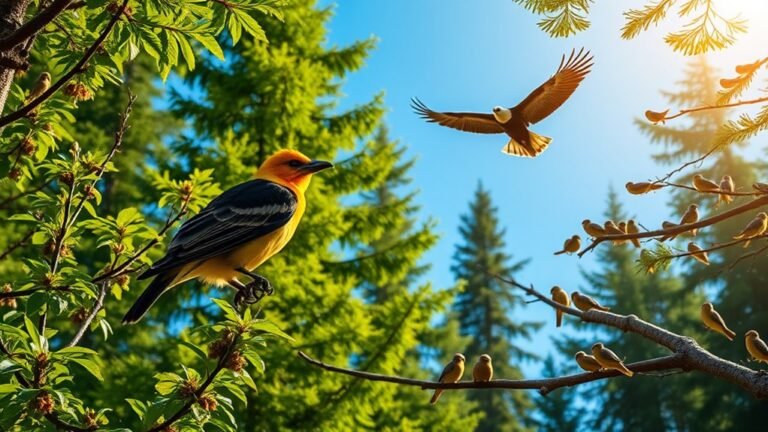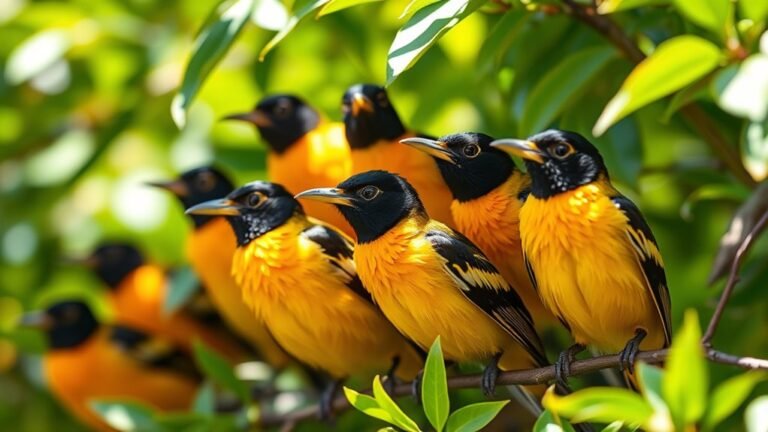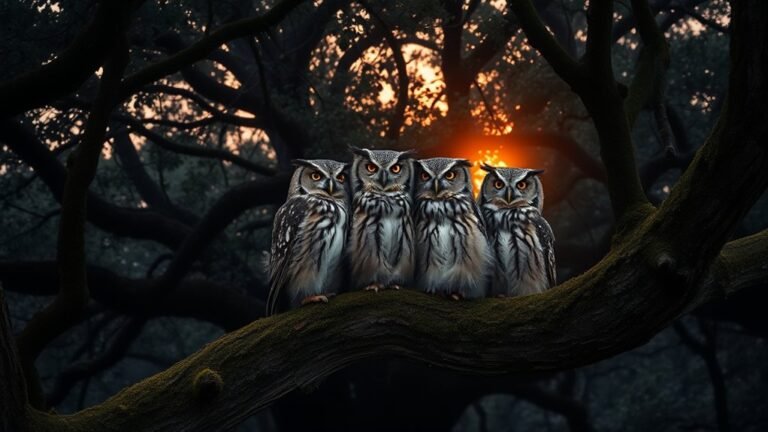Identifying Female Woodpeckers: Key Features
When you want to identify female woodpeckers, look for their unique traits. They usually have softer colors, like brown and green, which help them blend into their surroundings. Their feathers have simple patterns, and their crests, or the feathers on their heads, are round and less noticeable compared to male woodpeckers.
These features help them stay safe in their habitat. But there's more to these birds. Their behaviors and sounds also tell us a lot about them. So, pay attention to how they act and what noises they make, as these can help you know which woodpecker you are looking at.
A Quick Overview
Female woodpeckers have softer colors in their feathers. You usually see browns and greens. This helps them blend in with their surroundings. Their feather patterns often have spots or stripes that are less bright than the colors seen on male woodpeckers.
Female woodpeckers are generally smaller than males. They can weigh 10-20% less and have rounder crests. This makes them a bit different in appearance.
During mating season, females make unique sounds and drumming patterns. This helps others identify them.
Also, the colors of their feathers change with the seasons. In summer, their feathers can look brighter. In autumn, the colors become duller. This change can help you spot them throughout the year.
Understanding Woodpecker Sexual Dimorphism

Woodpeckers are interesting birds, and when we look at them, we notice something cool: males and females can look different. This difference is called sexual dimorphism.
Usually, male woodpeckers have brighter colors and special marks. These colorful features help them attract mates during the breeding season. Bright colors can show that a male is healthy and strong, which is important for having babies.
Where woodpeckers live also matters. The environment can change how they look. For example, woodpeckers living in thick forests might be different in size or color compared to those in open areas. These differences help them fit into their homes better.
Plumage Patterns: Color and Markings

Many woodpeckers have different colors and patterns that show if they're male or female. These colors can tell us a lot about how they live and their role in nature. Female woodpeckers often have special features that help us spot them.
- Color Change: Look for softer colors like browns and greens. These colors help them blend in with trees and leaves.
- Feather Feel: Check the feathers on female woodpeckers. They're usually softer than the stiffer feathers of the males.
- Unique Patterns: Notice any spots or stripes on their feathers. These patterns are often less bright than those on male woodpeckers. They help with hiding and communicating with each other.
These features not only help us tell different species of woodpeckers apart but also show us where these amazing birds live and how they fit into their environment.
Size Differences Between Genders

Woodpeckers might look similar, but there are big size differences between males and females. Male woodpeckers are usually bigger than females. This is called sexual dimorphism, which means males and females can look different in size.
For example, male woodpeckers can weigh 10-20% more than female woodpeckers. This size difference can change how they search for food and how they build nests. In birds like the Hairy Woodpecker, these roles matter.
Noticing these differences helps you understand how woodpeckers live and work together. By learning about their sizes, you can appreciate woodpeckers more and enjoy watching them in nature.
The Role of the Crest in Identification
When you watch woodpeckers, the crest helps you tell them apart. Here are some easy ways to identify them:
- Crest Size: Males usually have bigger and more noticeable crests than females. This makes it easier to tell who's who.
- Crest Color: Females often have softer colors, like brown or light shades. Males, on the other hand, show bright and bold colors. This difference helps in recognizing each gender.
- Crest Shape: The shape of the crest is different too. Females tend to have rounder crests, while males have more pointy or angular crests.
By looking at these traits, you can easily spot the differences between male and female woodpeckers.
Enjoy birdwatching!
Behavioral Characteristics Unique to Females
When you watch woodpeckers, you can see that female woodpeckers behave a bit differently from males. Foraging, or looking for food, is one area where they stand out.
Females often take their time. They check specific parts of trees slowly, making sure they find all the insects hidden inside.
During mating times, females show interest in males with special sounds and body movements. They do this confidently. Unlike males, females drum less often.
When they do drum, it's to catch a mate's attention.
This careful way of searching for food and courting mates shows how females balance finding food and attracting partners. Understanding these behaviors helps us appreciate the unique lives of these amazing birds.
Nesting Habits and Site Selection
Female woodpeckers are very picky about where they build their nests. They choose spots that help their baby birds survive. To find a good home, they look for places with plenty of resources. Building a nest is a careful job, and they want everything to be just right for their chicks.
Here are some important things they look for:
- Holes in dead trees – These holes keep the nest warm and safe from animals that might want to eat the eggs or chicks.
- Nearby water – Adult woodpeckers and their babies need water to drink, so they pick places close to lakes or streams.
- Nest materials – Female woodpeckers gather special items like wood chips, moss, and feathers to make the inside of the nest cozy and warm for their young ones.
Vocalizations: Identifying Calls and Drumming
Understanding how female woodpeckers communicate can be very interesting! They use different calls to share feelings and information. By listening closely, you can hear when they alert each other to dangers or when they're trying to find a mate.
Female woodpeckers have unique sounds that show who they are. They also have special drumming patterns. When they peck at trees for food, the way they drum can tell you about their health and energy.
Some woodpecker species even have different styles of drumming based on where they live, which helps you spot which group they belong to.
Seasonal Changes in Appearance
As the seasons change, female woodpeckers show different colors in their feathers.
These changes can help us understand them better. Here's what you might see:
- Summer: In summer, their feathers are bright and colorful. This helps them stand out and shows they're ready to find a mate.
- Autumn: In autumn, their colors become a bit dull. This helps them blend in with the leaves as they get ready for winter.
- Winter: During the cold months, you'll notice they've fluffy feathers. These layers keep them warm and help them stay hidden.
Watching these changes helps us learn about each species and how they adapt to different environments.
Knowing about their feathers helps us appreciate these amazing birds even more!
Regional Variations Among Species
When you look at female woodpeckers, you'll see interesting differences based on where they live. For example, woodpecker females in thick forests often have bright colors. In open areas, they've duller colors that help them blend in. These differences help them find food and choose where to build their nests.
Some woodpecker species fly long distances to find better places, while others stay in the same area all year. These changes in colors and behaviors show how woodpeckers adapt to their surroundings.
Tips for Observing Female Woodpeckers in the Wild
To see female woodpeckers in the wild, watch for them in their favorite spots at dawn or dusk. This is when they're the most active. Look for trees where they can find food and rest, especially those with insects hiding under the bark.
- Dense forests with both leafy and pine trees are great places to look.
- Dead or sick trees attract woodpeckers because they search for beetle larvae.
- Areas near rivers or lakes are good too, as they bring in lots of insects.
Keep your eyes open, and enjoy the beauty of nature as you search for these fascinating birds!
Frequently Asked Questions
Are Female Woodpeckers More Solitary Than Males?
Female woodpeckers tend to be more solitary than male woodpeckers, especially during mating seasons. This means they often prefer to be alone while finding a mate and setting up their territory. On the other hand, male woodpeckers like to hang out with other males more often.
Female woodpeckers focus on building their own space. They work hard to claim areas where they can find food and raise their young. Meanwhile, males are more social and interact with their fellow woodpeckers during this time.
How Can I Attract Female Woodpeckers to My Yard?
To attract female woodpeckers to your yard, you can start by setting up feeding stations. Use suet and seeds that woodpeckers like. These tasty treats will draw them in.
Next, think about where they can nest. Leaving dead trees standing can be a great option. If you don't have any, you can put up birdhouses.
Make sure your yard is a welcoming place. By offering food and safe spots to nest, you create a great home for these interesting birds. Enjoy watching them!
Do Female Woodpeckers Prefer Specific Types of Trees?
Female woodpeckers like certain types of trees, such as oaks and pines. They choose these trees because they provide homes and food. If you have these trees in your yard, you might see more woodpeckers visiting. It's a great way to make your yard more welcoming for these beautiful birds.
Can Female Woodpeckers Be Mistaken for Other Bird Species?
You might mix up female woodpeckers with other birds because they can look similar in color and size. But they have special behaviors that set them apart. For example, woodpeckers drum on trees in a unique way and look for food in specific spots. These habits make it easy to tell them apart when you see them in nature.
What Is the Lifespan of a Female Woodpecker?
A female woodpecker usually lives between 4 to 11 years. Many things can affect how long she lives. The place where she lives, the food she eats, and any animals that might hunt her all play a part in her life. It's interesting to watch these birds and see how they adapt to their surroundings.

Luna is the passionate founder and author of Birds and You, a website dedicated to sharing her love for birds with fellow enthusiasts. Through her engaging articles and guides, she aims to educate and inspire others to explore the fascinating world of birds. When she’s not writing, you can find Luna observing birds in their natural habitats or sharing beautiful bird photography on Pinterest. Join her on this journey to celebrate and protect our feathered friends!







